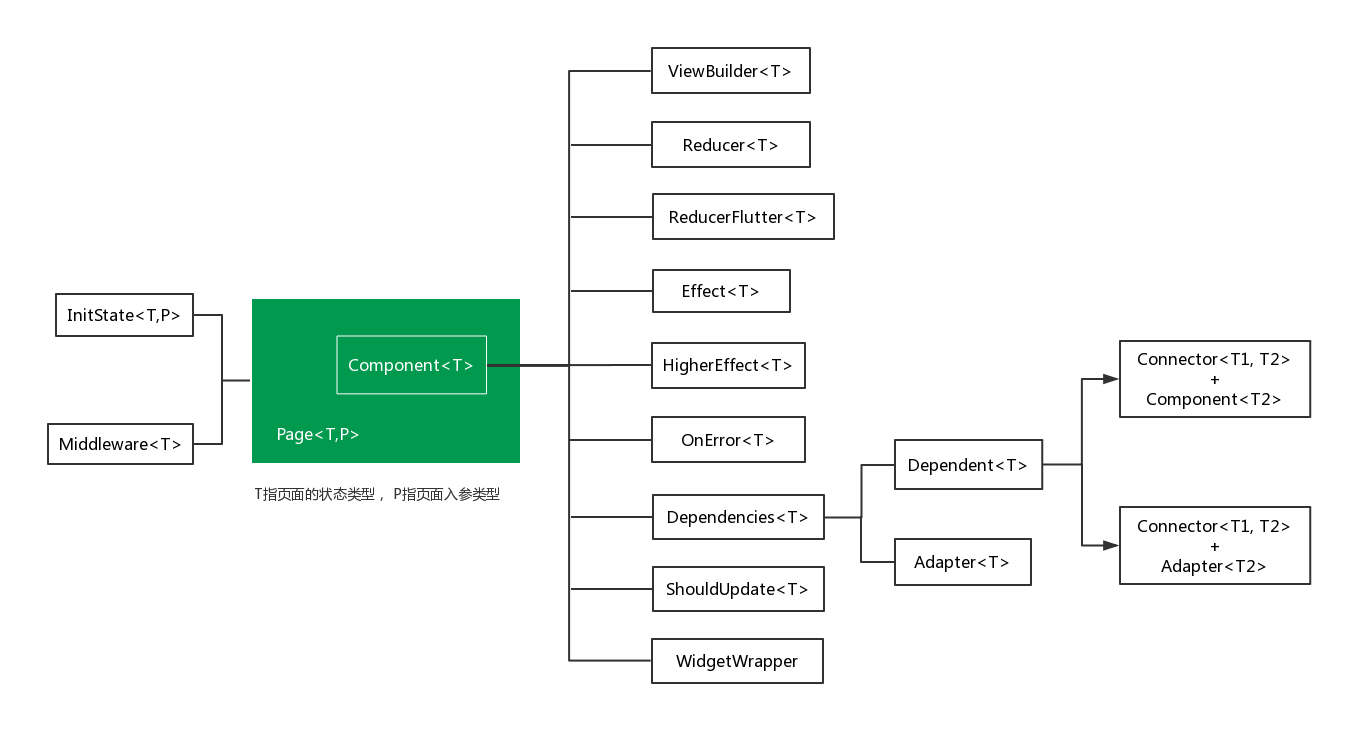fish-redux库的介绍
fish-redux是一个基于 Redux 数据管理的组装式 flutter 应用框架。现已由阿里闲鱼团队开源,项目地址:Fish Redux。
关于该库,官方也已经有了详细的介绍:刚刚,阿里宣布开源Flutter应用框架Fish Redux!。
但是,如果对Redux不太了解,或者刚接触Fish Redux不久, 肯定会有很多困惑、茫然,不知如何使用。因为相较于flutter-redux, fish-redux在它的基础上又抽象出了很多的概念,如Effect、Adapter、Dependent、Page等。想短时间内完全理解,确实很困难。这也是本文的目的,帮助我们更快的理解使用fish-redex。
fish-redux 的关系图
针对这么多的概念,我是通过画图的方式来加深理解的。
从图中可以看出,fish-redux大大小小的概念快20个了。下面详细介绍每个概念的作用以及彼此的关系。
fish-redux的详细介绍
Page<T, P>
T指状态的数据类型,P指页面的入参类型。
Page就是一个完整的页面,它继承自Component<T>。同时扩展出了两个参数:InitState<T, P>、Middleware<T>。
middleware的概念与Redux中是一致的。
initState的作用是将打开页面时传入的参数类型为P的值对应到状态T中,控制页面初始的显示内容。
如何打开一个页面?
1
2
3
4
5
6
7
8
9
10
11
12
13
14
15
16
17
18
19
20
21
22
23
24
25
26
27
28
29
30
31
32
//创建一个Page
class MyPage extends Page<PageState, List<String>> {
....
}
void main() => runApp(createApp());
Widget createApp() {
//将page添加到routes
final AbstractRoutes routes = HybridRoutes(routes: [
PageRoutes(
pages: <String, Page<Object, dynamic>> {
"home_page": MyPage()
}
)
]);
return MaterialApp(
title: "Test fish redux",
debugShowCheckedModeBanner: false,
theme: ThemeData(
primarySwatch: Colors.blue,
),
//通过routes.buildPage的方式生成一个Widget
home: routes.buildPage("home_page", ["android", "iOS", "flutter", "java", "kotlin", "dart"]),
onGenerateRoute: (settings) {
return MaterialPageRoute<Object>(builder: (context) {
return routes.buildPage(settings.name, settings.arguments);
});
},
);
}
从上面的例子可以看出,通过AbstractRoutes.buildPage(String key, dynamic arguments)来生成页面对应的Widget。而页面传参就是通过第二个参数来传递的。
Component<T>
Page的大部分功能都是Component提供的。Component字面意思就是组件,很明显它是为了控件的复用而存在的。它的特点有:复用、低耦合、即插即用等。
组件的参数比较多,下面逐个介绍。
ViewBuilder<T> view
首先看下ViewBuilder的定义:
1
2
3
4
5
typedef ViewBuilder<T> = Widget Function(
T state,
Dispatch dispatch,
ViewService viewService,
);
它的作用是提供组件的UI展示。state存储着当前的组件状态,dispatch用来发射事件,viewService用来绑定子组件或者adapter。
关于
viewService,后面有例子帮助理解。
Reducer<T> reducer
reducer的定义:
1
typedef Reducer<T> = T Function(T state, Action action);
Action是框架提供的固定类型,定义如下:
1
2
3
4
5
class Action {
const Action(this.type, {this.payload});
final Object type;
final dynamic payload;
}
reducer的作用就不在详述了。
ReducerFilter<T> filter
filter的定义:
1
typedef ReducerFilter<T> = bool Function(T state, Action action);
它的作用是为组件过滤不必要的事件。只有返回值是true的action会进入到reducer处理。
Effect<T> effect
effect的定义:
1
typedef Effect<T> = dynamic Function(Action action, Context<T> ctx);
ctx提供组件的上下文,包括了state、dispatch、BuildContext context,以及appBroadcast、pageBroadcast action。
它与reducer有点像,都是处理特定的action事件。区别有以下几点:
effect处理非修改数据的行为事件,reducer处理修改数据的行为事件。effect返回bool或Future,reducer无返回值
如果effect的返回值是一个非空值(not null , not false),则代表自己优先处理,不再做下一步的动作;否则广播给其他组件的 Effect 部分,同时发送给 Reducer。
约定
effect接收的action.type以on开头,reducer的以非on开头。
看源码,是将effect转成middleware, 如果返回值满足条件,就不在next了。
1
2
3
4
5
6
7
8
9
10
11
12
13
14
15
16
17
18
19
20
21
22
23
24
25
26
27
28
29
30
31
32
33
34
35
36
37
38
Dispatch createDispatch(
OnAction onAction, Context<T> ctx, Dispatch parentDispatch) {
Dispatch dispatch = (Action action) {
throw Exception(
'Dispatching while appending your effect & onError to dispatch is not allowed.');
};
/// attach to store.dispatch
dispatch = _applyOnAction<T>(onAction, ctx)(
dispatch: (Action action) => dispatch(action),
getState: () => ctx.state,
)(parentDispatch);
return dispatch;
}
static Middleware<T> _applyOnAction<T>(OnAction onAction, Context<T> ctx) {
return ({Dispatch dispatch, Get<T> getState}) {
return (Dispatch next) {
return (Action action) {
final Object result = onAction?.call(action);
if (result != null && result != false) {
return;
}
//skip-lifecycle-actions
if (action.type is Lifecycle) {
return;
}
if (!shouldBeInterruptedBeforeReducer(action)) {
ctx.pageBroadcast(action);
}
next(action);
};
};
};
}
HigherEffect<T> higherEffect
higherEffect是effect的升级版,它允许拥有自己的临时状态。
如:
1
2
3
4
5
6
7
8
9
10
11
12
13
14
15
16
17
18
19
20
21
22
23
24
25
26
27
28
29
30
31
32
33
class PageEffectPart extends EffectPart<PageState> {
//higher effect的状态变量
bool addFlag = true;
@override
Map<Object, OnAction> createMap() {
return {
PageType.OnAuto: _pageEffect
};
}
void _pageEffect(Action action) {
print("at higher effect: ${action.type}");
if (addFlag) {
dispatch(ActionCreator.addData());
} else {
dispatch(ActionCreator.deleteData());
}
addFlag = !addFlag;
}
}
class MyPage extends Page<PageState, List<String>> {
MyPage()
: super(
...
higherEffect: higherEffect(() => PageEffectPart()),
...
}
higherEffect、effect同时只能设置其中一个。
OnError<T> onError
onError的定义:
1
typedef OnError<T> = bool Function(Exception exception, Context<T> ctx);
它用来处理effect中的异常。返回true,代表已处理,返回false代表不处理,继续抛出该异常。
Dependencies<T> dependencies
它的作用是给当前组件提供其他组件或者Adapter。
dependencies接收两个入参:Map<String, Dependent<T>> slots 、AbstractAdapter<T> adapter。
slots的作用是给ViewBuilder提供子组件,在ViewBuilder中通过ViewService.buildComponent(key)来使用,key值就是Map的key。
Dependent = Connnector + Component。因为子组件的状态与当前组件的状态,类型不一致,需要使用connector来转换沟通。
如:
1
2
3
4
5
6
7
8
9
10
11
class MyPage extends Page<PageState, List<String>> {
MyPage()
: super(
//...
dependencies: Dependencies(
slots: {
"count": CountConnector() + CountComponent()
}
),
//...
}
adapter的作用是给组件中ListView提供ListAdapter的。在ViewBuilder中通过ViewService.buildAdapter()来获取ListAdapter。
ShouldUpdate<T> shouldUpdate
shouldUpdate的定义:
1
typedef ShouldUpdate<T> = bool Function(T old, T now);
它的作用是决定组件是否需要重新更新。
通过比较old、now两种状态,默认逻辑是:若两个变量不相等就刷新。
1
2
static ShouldUpdate<K> updateByDefault<K>() =>
(K _, K __) => !identical(_, __);
WidgetWrapper wrapper
wrapper的定义:
1
typedef WidgetWrapper = Widget Function(Widget child);
它的作用是包裹ViewBuilder的内容。
List<Middleware<T>> middleware
middleware的定义:
1
2
3
4
typedef Middleware<T> = Composable<Dispatch> Function({
Dispatch dispatch,
Get<T> getState,
});
Composable的定义:
1
typedef Composable<T> = T Function(T next);
如何定义一个middleware:
1
2
3
4
5
6
7
8
Composable<Dispatch> pageMiddleware({Dispatch dispatch, Get<PageState> getState}) {
return (Dispatch next) {
return (Action action) {
//do something
next(action);
};
};
}
发射事件的处理流程依次是:
effect->middleware->reducer。
fish-redux的项目结构
推荐的项目结构:
main.dart
- page-1-package
- page.dart
- action.dart
- reducer.dart
- effect.dart
- middleware.dart
- view.dart
- state.dart
- adapter-package
- …
- component-package
- …
- page-2-package

